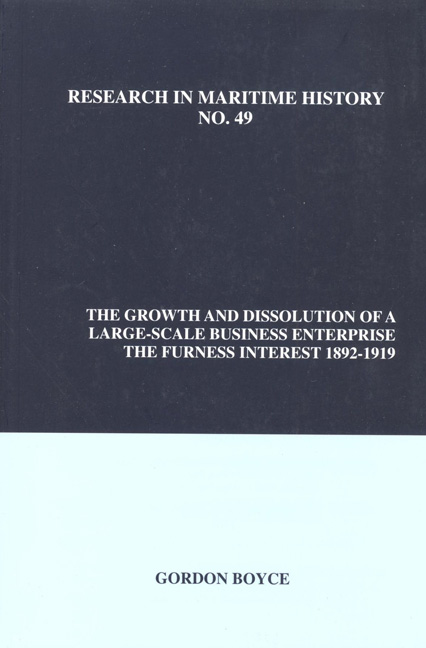Book contents
- Frontmatter
- Table of Contents
- About the Author
- Acknowledgements
- Figures and Tables
- Introduction
- Chapter 1 Furness' Shipping Services: Growth by Organic Means in the 1880s
- Chapter 2 The 1890s: Furness Withy's Expansion by Acquisition and Promotion
- Chapter 3 Diversification into the Industrial Sector, 1895-1901
- Chapter 4 Trouble on the Transatlantic Route: The Formation of the IMM and Furness' Response
- Chapter 5 The Growth of Shipping Services, 1902-1909
- Chapter 6 Industrial Operations and Performance, 1900-1914
- Chapter 7 The Growth of the Shipping Interests, 1910-1919
- Chapter 8 Structure
- Chapter 9 Finance
- Chapter 10 Holding Company Investment Activities and Intermediary Operations
- Chapter 11 Personnel
- Chapter 12 Furness
- Chapter 13 Dissolution
- Appendix 1 Development of the Combined Fleet, 1900-1919
- Appendix 2a Patterns of Ownership: The Furness Group, 1919
- Appendix 2b Reorganization of Branch Offices and Superintending Departments, 1911-1912
- Appendix 3a Fluctuations in Freights, Profits, Tonnage Afloat and Merchant Shipping Output
- Appendix 3b Output of Merchant Tonnage (Excluding Warships), 1892-1913
- Appendix 3c Fluctuations in the Price of a 7500-ton Cargo Steamer, 1898-1913
- Appendix 4 Development of the Furness Group: Principal Promotions, Acquisitions and Divestments, 1880-1919
- Appendix 5 Northern Allies and Maritime Associates
- Appendix 6 Contemporary Accounting Law and Conventions, 1845-1914
- Appendix 7 Lord Furness' Movements, 1899-1912
- Bibliography
Appendix 6 - Contemporary Accounting Law and Conventions, 1845-1914
- Frontmatter
- Table of Contents
- About the Author
- Acknowledgements
- Figures and Tables
- Introduction
- Chapter 1 Furness' Shipping Services: Growth by Organic Means in the 1880s
- Chapter 2 The 1890s: Furness Withy's Expansion by Acquisition and Promotion
- Chapter 3 Diversification into the Industrial Sector, 1895-1901
- Chapter 4 Trouble on the Transatlantic Route: The Formation of the IMM and Furness' Response
- Chapter 5 The Growth of Shipping Services, 1902-1909
- Chapter 6 Industrial Operations and Performance, 1900-1914
- Chapter 7 The Growth of the Shipping Interests, 1910-1919
- Chapter 8 Structure
- Chapter 9 Finance
- Chapter 10 Holding Company Investment Activities and Intermediary Operations
- Chapter 11 Personnel
- Chapter 12 Furness
- Chapter 13 Dissolution
- Appendix 1 Development of the Combined Fleet, 1900-1919
- Appendix 2a Patterns of Ownership: The Furness Group, 1919
- Appendix 2b Reorganization of Branch Offices and Superintending Departments, 1911-1912
- Appendix 3a Fluctuations in Freights, Profits, Tonnage Afloat and Merchant Shipping Output
- Appendix 3b Output of Merchant Tonnage (Excluding Warships), 1892-1913
- Appendix 3c Fluctuations in the Price of a 7500-ton Cargo Steamer, 1898-1913
- Appendix 4 Development of the Furness Group: Principal Promotions, Acquisitions and Divestments, 1880-1919
- Appendix 5 Northern Allies and Maritime Associates
- Appendix 6 Contemporary Accounting Law and Conventions, 1845-1914
- Appendix 7 Lord Furness' Movements, 1899-1912
- Bibliography
Summary
The nature of the financial disclosures required from railways and other companies established by an Act of Parliament provided a model for subsequent accounting practice. Drawing upon the various provisions laid down for these companies, the Company Clauses Consolidation Act of 1845 required firms to produce a balance sheet which contained a valuation of the capital stock, credits, property and debts. Further, the Act compelled firms to report on the profit or loss arising from operations. The 1845 Act also required that the balance sheet presented to shareholders at the Annual General Meeting (AGM) be audited, but it did not state that professionally qualified auditors were to draw up the document. The chief aims of these early balance sheets were simply to provide a statement regarding the solvency of the firm and to give investors the means to determine whether dividends had been paid out of capital.
Even though the Joint Stock Company Act of 1856 provided model articles of association which included provisions for record keeping, the presentation of a profitand- loss account at the AGMs, and an audit of these statements, it did not make the last two requirements compulsory. Nor did the Company Act of 1862 alter this state of affairs. Up to 1900, therefore, reporting remained entirely voluntary. Consequently, after 1862, the development of the form of these records that were to be voluntarily published grew out of accounting conventions rather than legislation because even though there was pressure to revise reporting practice, this was not sufficiently strong to overcome the reticence of the judiciary to intrude into what it viewed as the private affairs of companies.
The Company Act of 1900 did reintroduce the compulsory auditing of reports but did not require the auditor to be professionally qualified. The publication of financial statements also remained voluntary, but the Act did instruct firms to place these documents before the shareholders at AGMs. Ironically, the Act contained much tighter regulations for the information disclosed in prospectuses for new firms than it did for the annual reports of existing concerns.
- Type
- Chapter
- Information
- The Growth and Dissolution of a Large-Scale Business EnterpriseThe Furness Interest, 1892-1919, pp. 385 - 386Publisher: Liverpool University PressPrint publication year: 2012



